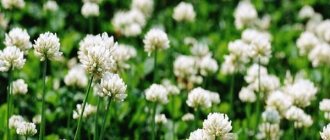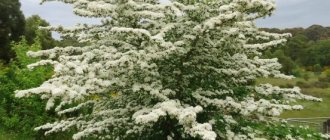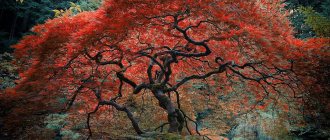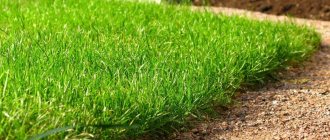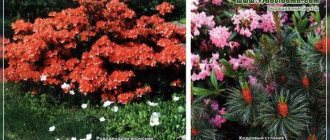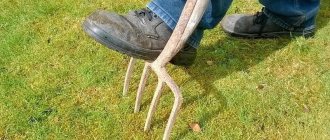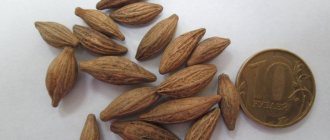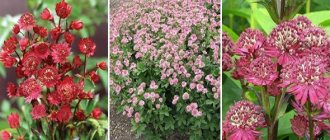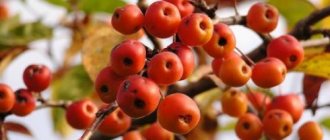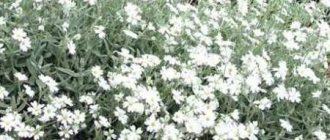Editor Lawn and Soil 33012
A clover lawn is a godsend for large areas. In places where yesterday weeds were rampant and bare earth looked inhospitably, a soft, lush carpet will bloom. Many gardeners, when talking about clover, prefer to replace the concept of lawn with lawn or meadow.
The perennial grass belongs to the legume family. It looks very cute thanks to the small pompom flowers against the background of emerald patterned leaves. In the stage of an adult developed plant, it quickly spreads and covers the entire available area. More than 300 varieties are known. For home plantings, choose one low-growing species.
The second name is trefoil. This definition in Latin means the presence of three leaves. Finding four leaves was considered a happy omen. However, varieties have now been bred in which all leaves are quadruple. The main purpose of the crop is food for herbivores. Contains a lot of nutrients. It is grown and harvested in agriculture.
Main types
About 20 varieties are used in landscape design. They differ in height, color and decorative value. Used to create a flowering carpet on lawns and lawns. They look good among the stones of an alpine hill and rockery.
To avoid disappointment, you need to know in detail about the variety you are going to purchase.
meadow clover
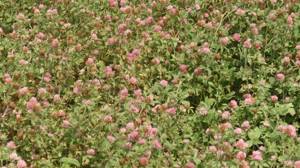
Common wild species. The flowers are pink or reddish. Spreads across meadows, fields, mountains. Unpretentious and tenacious.
White clover (creeping)
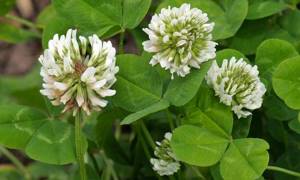
The perennial plant is a creeping species. Spreads along the ground, stem length up to 40 cm. Leaves are round, triple. Tolerates trampling, frost, and drought. Blooms with white balls. A white clover lawn rises 10 cm from the ground, but in the wild it can grow up to 30.
Variety Atropurpurea
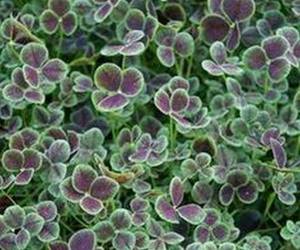
Artificially bred decorative appearance. The leaves are dark purple. The edge seems to be outlined with a green pencil. Loves sunny places. It is under the influence of bright light that it acquires its color. In the shade it will turn green and lose its originality. Leaves of three and four blades.
Variety Purpurascens
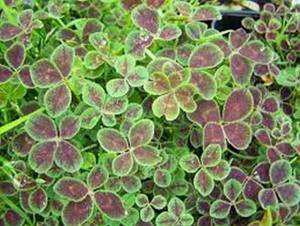
Designed for decorative flower beds. Four-leaved. Brown-red paint seemed to flow on each leaf, leaving the edges and veins a rich green. Quickly takes over the entire surrounding space.
Variety Good Luck
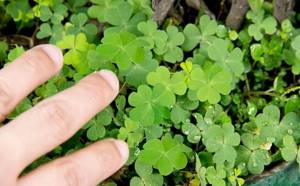
Interesting color of four leaves. In the center there is a brown spot with jagged edges and light brown streaks. Most of the leaf is green with light green veins.
pink clover
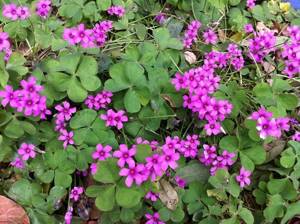
Blooms with pink and white balls. In terms of vitality, it is superior to the meadow variety. Unpretentious to high soil acidity. Loves moisture. The period of active flowering is from early summer to autumn. There are three leaves per stem.
Red clover
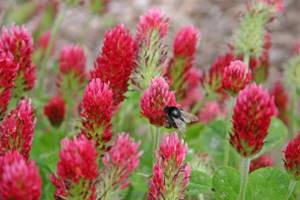
This is a bush up to 60 cm tall. The inflorescences are elongated, large, raspberry-red. The leaves are large, three-fingered. It begins to bloom continuously from the beginning of July. It spreads better by seeds. When you try to divide the bush, a fifth of it takes root. Wild species are protected by law.
The best decorative varieties of clover for the lawn
More than three hundred varieties of this plant are known. Gardeners and landscape designers sow white clover for lawns more often than other varieties. Perennial clover lawn can tolerate:
- night temperature drops;
- trampling;
- mowing.
Hydrangea Magical Moonlight - variety description, planting and care
Low-growing white lawn clover looks good in combination with pink field clover. These varieties are often found in nature; they can be found in the Caucasus and Crimea. Both crops tolerate frost and trampling well. They have the usual three-leaf structure and ovoid-shaped flowers.
Important! For the lawn, you need to choose only those varieties that grow low above the ground surface. Creeping plant species are well suited for this purpose.
In addition to the most famous meadow pink and white, red meadow clover is also suitable for lawns.
There are several more varieties of this crop suitable for organizing a garden lawn:
- Barbian. Resistant to freezing, suitable for organizing a functional lawn. After mowing, it quickly grows new shoots and foliage.
- Liflex. Decorative clover, it blooms earlier than other varieties. Suitable for growing as part of a decorative flower arrangement on alpine hills, flower beds and sowing a lawn.
- Nanook. Decorative variety. Nanook clover is used to decorate the landscape and organize functional lawns.
- Pipolina. Microclover with small leaves and twigs. Low-growing clover is suitable for seeding lawns.
- Pirouette. Mini clover was bred for decorating lawns and flower beds. Medium flowering variety. Low-growing clover for lawns and decorative flower beds.
- Rivendell. Early flowering variety. A plant with a large number of inflorescences.
- Sylvester. Medium flowering plant, tolerates frosty winters well. Creates a stable lawn surface.

Barbian
Conditions for a flowering carpet
Since wild shamrock is very tenacious, its cultivated brothers do not require special conditions.
Soil with neutral or weak acidity is preferable. Reacts well to fertilizers. Enriches the soil after cereals. It spreads better over loamy and sandy soil.
The sun is always a priority. In shaded areas, it is more susceptible to fungus and gets sick.
The plant really needs moisture. It is the combination of sun and humidity that promote flowering, propagation, and restoration. However, excess attracts slugs and snails. The roots begin to rot.
Weeds must be removed at the beginning of the lawn colonization. In the second year, the shamrock will get rid of itself, leaving them no chance. If clover is left out of control, it will itself become a fast-spreading weed.
Reproduction. Seeds must be collected from biennial plants. Choose large, dry heads. Dry them in a shaded place for a week, then you can put them away for storage. Sow to a depth of 3 cm.
Unusual lawns
A lawn at the dacha has long ceased to be a luxury: from the many types it is quite possible to choose one that is suitable in terms of price and quality. If your choice fell on the classic English version, tips on the rules of arrangement, sowing, and seasonal care will help you get a high-quality green lawn. Well, for those who decided to give preference to not so familiar types of lawn - Moorish and white clover, an impartial review of their qualities would be useful.
Moorish lawn
After all, only the advantages are indicated on bags of seeds, and manufacturers prefer not to talk about the disadvantages, so as not to scare off a potential buyer. Well, we will take a comprehensive look at flower and clover lawns so that summer residents can form their own opinion about them.
Fertilizers
Shamrock is a very nutritious plant and loves to be treated the same way. Before you sow it, you need to think about fertilizers:
- organic fertilizers (manure) are applied only in the fall for digging;
- fertilizer with a phosphorus-potassium composition is added to the clover lawn; further, no more than once every two months;
- on podzolic soils it is necessary to spray the green mass at the beginning of flowering with boron fertilizers;
- All fertilizers with nitrogen additives should be excluded; Clover itself accumulates nitrogen and cannot tolerate its overdose.
Completely unnecessary: calcium nitrate, ammonium nitrate; sodium nitrate; ammonium chloride.
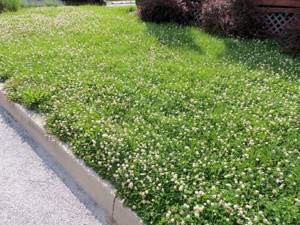
Lawn care tips
An important condition for a high-quality clover lawn is watering. Insufficient irrigation can lead to a decrease in the decorativeness of the site. Overwatering will completely ruin your lawn. Therefore, regular watering is necessary, but in small doses. The frequency of irrigation should not exceed once every seven days.
Regular fertilizing is not necessary for the clover lawn, especially if you do not overdo it with those that contain nitrogen substances. White clover's unique root system contains nodules that absorb nitrogen from the atmosphere. Thanks to such clover plantings , the soil is enriched, and the crops are used to increase the fertility of garden plots.
Sowing
The best time is the end of summer. The plant will take root and grow well before frost. The soil is completely cleared of weeds. Fertilizers are applied as necessary. Then it is carefully compacted. Seeds are scattered like lawn grass. Embedded in the soil up to three centimeters.
If it is possible to calculate, sowing should be carried out during the rainy season. Watering is required daily, so a natural option will reduce costs and effort.
Combination with other plants
On the ground, the shamrock behaves aggressively. He is an invader of new territories. If you plan to combine its sowing with other plants, then you need to stimulate their growth with mineral fertilizers.
Looks great under bushes and trees. When planting different varieties in a flower garden, it is better to isolate them with a small border.
How to create a clover lawn?
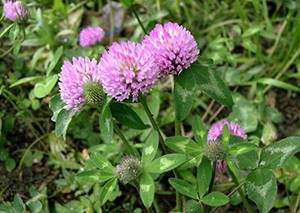
Strict adherence to planting rules is a guarantee of obtaining a beautiful and durable lawn covering.
To grow an even green “carpet”, it is necessary to allocate sunny or semi-shaded areas for sowing.
It is very difficult for mature ornamental plants to take root, so it is advisable to grow trefoil from seed.
Technology for proper sowing of trefoil to create a decorative lawn in the local area:
- digging up the ground, removing weeds and leveling the surface;
- soaking seeds in warm water, calculating 300 seeds per square meter of sown area;
- uniform sowing of seed material and backfilling with a centimeter layer of soil;
- watering an area with crops from a sprinkler.
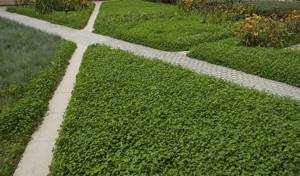
Growing clover
If you follow the planting rules, the first shoots appear in about a couple of weeks, but the ornamental crop will bloom profusely only next year.
To obtain the most uniform sowing of seed material, you should use special seeders or mix the seeds with a small amount of sifted sand.
A haircut
Often, after mowing, a clover lawn is disappointing with dry stems and uneven color, but after a couple of days the appearance is restored. Unattractiveness is characteristic of the pink shamrock. The cropped white look looks like a neat green rug.
No careful care required. For cutting, it is better to use a trimmer or a gasoline lawn mower. The cover is too dense for the lawnmower. The result is wavy and ugly.
It is enough to cut the white variety once every half month. For wild-looking meadows, treatment twice a season is sufficient. You should get rid of 4 cm of the top layer.
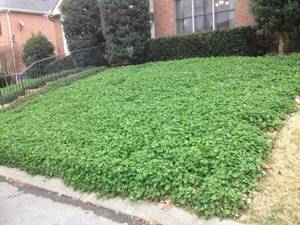
Advantageous characteristics of a lawn
The main advantages should be noted:
- Lawns have a very dense structure; there will be no bald spots or weeds on such surfaces. Creeping crops with the help of “tendrils” fill the entire area, covering it with small but rather dense leaves in the shape of trefoils.
- Excellent decorative qualities. Clover leaves are rounded, changing color depending on the intensity of lighting in the area. The shade of the lawn can vary from emerald to rich green, visually creating lushness and volume to the surface. In addition, throughout the summer season the plants will bloom, decorating the green meadows.
- The low-growing white variety of clover does not need to be trimmed frequently. Over the entire duration of the season, you only need to use a trimmer or lawn mower three times. After cutting, the crops are restored within three days. Very often, clover lawns are not mowed.
- The coating is highly resistant to trampling. As a result of even technical abrasion, the lawn is restored within a few days.
- Clover is great for using and arranging lawns on slopes and artificial uneven surfaces created by designers. The strong root system is very creeping in all directions, the crop rests on various steep slopes. The main conditions for replenishing the coating are lighting and high-quality watering.
- White clover combines well with other grasses to fill bald spots in the lawn. The culture is growing. In a few weeks it covers trampled paths, restoring them.
- The lawn is safe for children and animals. The crop does not require any fertilizers. Considered environmentally friendly.
- Bacteria that form on the clover root system fill the soil with nitrogen. In mixed lawns, this property is especially favorable for other grasses, and this way the area can be artificially fertilized.
Bloom
Lawn clover reveals its beauty in its second year. Fluffy pom-poms will appear in friendly rows from late spring and throughout the summer. Then, it is recommended to mow the first wave. September, October the second wave of flowering will begin.
Why is it worth decorating your area with cute lambs?
The most important advantage is the beauty and freshness of a soft carpet. But there are also advantages:
- soil fertility increases; it is saturated with nitrogen;
- proximity to the crop strengthens the resistance of neighboring plants to diseases; especially favorable for cereals;
- bright juicy greenery pleases the eye until late autumn;
- lawn maintenance costs are minimal;
- quickly restores a thick and dense cover after mowing;
- resistant to trampling;
- performs well where ordinary lawn grass does not grow;
- Mown shamrock works great as mulch.
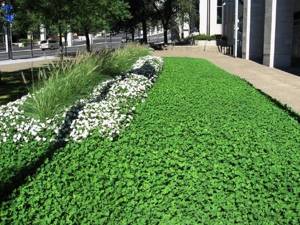
White clover in landscape design
The decorative value of such lawns is beyond any doubt.
It is advisable to install coverings not at the main entrances, but in gardens, sports fields, and children's areas. On dry soils and infertile soil, grass mixtures are often used in equal parts (about 25%) of red fescue, common bentgrass, meadow grass, and white clover. When combining the sowing of creeping crops with other plantings, it is worth stimulating the growth of other grasses with mineral fertilizers. Different varieties must be decoratively fenced with borders.
By choosing creeping clover as a base for your lawn, you get a lush, vibrant lawn with minimal maintenance. Proper cultivation will ensure a long service life for coatings. A spectacular grass lawn will be an excellent decoration for your garden plot.
What kind of trouble can clover cause?
It is imperative to consider the disadvantages of trefoil carpets:
- fading brown heads must be removed periodically;
- after rain, the lawn takes a long time to dry out due to its dense structure;
- high air humidity makes the surface slippery; especially dangerous on slopes;
- the plant crawls to other flower beds and new territories; it is difficult to get rid of it;
- due to the tight closure of the leaves, the layer at the roots is constantly wet; fungal infections spread quickly;
- nitrogen-containing nodules attract harmful insects, click beetles;
- fragrant flowers delight not only people, but also bees; there are always enough of them above the flowering carpet; It is advisable to plant the crop in the garden, then there will be enough insects for pollination;
- if you cut with a lawn mower, you will have to clean it often; it is filled with juicy greens.
A lawn of blooming, lush grass is just what you need for those who like to enjoy greenery without getting overtired. Little effort. The result is long-lasting, bright and impressive.
Clover lawn from scratch, its advantages and disadvantages
How to make a lawn from clover and is it worth doing at all?
Articles about lawns are usually not interesting to read; they are all kind of dry in accounting. “Remove 10 centimeters of turf, put 10 centimeters of turf. Pour 100 grams per 100 square decimeters”... No, for people with creative ambitions this is all no good?
Let me start by saying that I am by no means a professional when it comes to lawns. If I were a professional, I would write about 10 centimeters of turf. And in general, I never wanted, never made or saw a lawn. Well, there are many men who dream of a lawn as some kind of symbol of home well-being or something like that. And for sure, there are many women who dream of a lawn. But all my life I have been indifferent to lawns.
I had to do the lawn. Since there is a certain amount of empty land around the newly built house... After construction, something incomprehensible began to grow there - prickly thistle, quinoa, some cereals the size of a man... It is clear that it cannot be left like this - or everything must be concreted/asphalted, which is unacceptable for me . Or a lawn. The lawn is acceptable to me, although I have never done it.
Neighbors again. Then you’ll go to one. then to another. They proudly show off their lawns. I look... well, grass and grass, shaved like a beaver. Business. “No, I’ll be original - I’ll make a lawn from clover,” I decided, because I had a pack of white clover seeds lying around for an area of 500 square meters. (For comparison, the cost of lawn mixtures for the same area would cost 10 times more.)
But before sowing clover, it was necessary to give the surrounding soil at least some semblance of flatness and add at least a small fertile layer.
For leveling, about 50 cubic meters of sand were used and the same amount of black earth was dumped on top. The result was a relatively fertile layer of about 10 centimeters. The workers hastily leveled it out for me with a rake. Finally, before leaving, the last and most important worker revealed a professional secret (almost in a whisper, when the rest of his colleagues were already sitting in the running car, ready to leave) - it turns out that before sowing the grass, all this black soil should also be compacted . Somehow I didn’t attach much importance to these words - well, it will be necessary - we’ll compact it.
It started to rain... The black soil somehow compacted itself in some places, but not in others. It became clear that the option of “scattering the seeds now and waiting” would not give a very good result.
I had to go online and read about trampling and compacting lawns. There were all kinds of funny ways there. And pour water into the barrel and roll it. And take a sheet of plywood, lay it on the ground and jump on this plywood, preferably with a family of at least three people. Special rollers for lawns were also considered.
I liked the idea with the skating rink. I went to gardening stores. In one of them there was a skating rink, weighing three hundred kilograms and the size of half a car. In another they said that it was not yet the season, but they would deliver it soon... And it was already the month of May. There was no point in waiting until their season started.
Well, then I would have used the method with an improvised skating rink - half a pole from high-voltage lines was lying on the site. What that pillar was doing there, I don’t know. But I adapted it precisely as a skating rink. Drive - foot. That is, you walk and push this log with your foot, and it rolls for some distance. We rolled the log leisurely for a week, one at a time, as long as anyone wanted. They compacted it somehow, not perfectly of course. But I didn’t have the task of doing it perfectly.
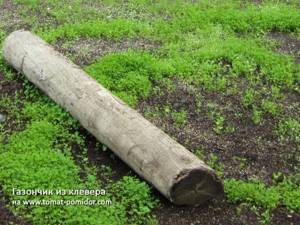
As for the “sowing” itself, everything was simple with it. He picked up a bag of clover seeds and walked around, sprinkling them in a sweeping manner. Then I found a few more packets of grass seeds in the bins, and scattered them here and there too—not to let the goodness go to waste. I also sowed alfalfa along the fence for added beauty. It's a lawn! I walked over the top with a log and rolled out the seeds...
Sowing lawn grass, even clover, must be done before the rains. To do this, we look at the weather forecast, and if no precipitation is expected, then we will have to water, otherwise nothing good will grow.
In May it was not very damp, but it still rained sometimes. The clover and some of the grass came up quite quickly, and I periodically walked and sometimes rolled this thing with a log. When the places where bald patches had formed became clearly visible, he sowed more grass. And clover.
Based on numerous recommendations I read on the Internet, I knew that the grass should be mowed when it reaches a size of about 10 centimeters. But firstly, I had no time, and secondly, I was lazy. And thirdly, I didn’t have a lawnmower. There was a trimmer, like a brushcutter, with a fishing line. I used it to mow the second part of the area, where the lawn had not yet been planned, and is not planned, there we have something like a natural meadow.
So, due to the lack of a mower and laziness, until August I did not mow the clover at all. Well, I didn’t mow the grass either.
Pros and cons of a clover lawn.
By August, the clover had grown so much that it became obvious that it was necessary to mow this thing down. I must say that I hoped that the white creeping clover would form a beautiful, even rug, no more than 10 centimeters in height. The peaceful buzzing of bees, the emerald green of clover leaves and the blue sky, ah-ah... Something like this should have happened according to my calculations.
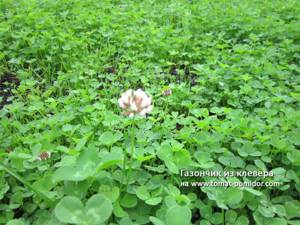
But we liked the clover on our site. I liked it very much. The white creeping clover was a great success, it was 30 centimeters tall, bloomed profusely and was not easily mowed with a trimmer and fishing line, because it was always damp in the depths.
In addition, if it was not damp, but dry and hot, then the clover became sluggish and fell down with all its 30 centimeters, so again it was not easy to mow it.
Another disadvantage of such mowing with a fishing line was the rather obscene appearance of the improvised lawn - brown dry leaves, stalks and other remains of clover look untidy for several days after mowing. This is probably the main disadvantage of a clover lawn. Although, already three days later, the clearing was filled with fresh, bright leaves.
- The second disadvantage is that if you have slopes on your site, then keep in mind that mown clover becomes very slippery.
- The third minus is quite relative; for some it may be a plus. Keep in mind that this is creeping . He quickly covers up all sorts of bald spots, but at the same time he strives to crawl out wherever he was not invited - into the beds, flower beds, etc.
- The fourth disadvantage is that by autumn there were a lot of snails and slugs in the clover. But mowing in wet weather is bad.
Now let's look at the advantages of clover as a lawn grass.
- Clover forms a very dense, well-knit turf.
- If mowed infrequently and allowed to bloom, clover provides food and attracts bees, bumblebees and other pollinators to the area.
- The clover lawn is actually beautiful. But not for everyone.
- Clover is unpretentious, germinates quickly and grows quickly.
- Clover is resistant to trampling. I couldn’t make the path, no matter how hard I tried.
- Clover enriches the soil with nitrogen. And the mulch from mowed clover turns out wonderful.

Our sea pig Gavryusha had a very positive attitude towards planting clover. All summer he devoured huge amounts of clover with great pleasure, looked askance at all other vegetables and ate them reluctantly.
Conclusions. It’s too early to call what I got a lawn. But if you compare it with what happened before, it’s not bad at all. Next year I will try to convert part of the lawn with clover into a regular grass lawn. With grass there are fewer snails. But I’m not going to give up clover completely.
By the way, in September I finally bought a normal gasoline lawn mower and tried it on clover. It turned out much faster and better than with a trimmer.
Next summer I plan to transform the existing lawn into something much more deserving of the name “Lawn”.
Addition from 2013.
See comment and photo here.
Addendum dated June 6, 2015.
This year I was absent for almost the entire month of June and therefore did not mow the lawn. I thought that upon arrival I would see a terrible picture of total desolation and intoxication. But nothing happened, the lawn was quite good, and the clover finally bloomed this year (the summer was dry and cool, which is why it bloomed so late). So for those who don’t like to mow often, clover is just what you need!
Please enlarge the photos, they look good
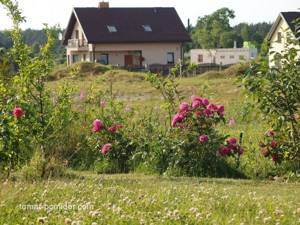
ps Thank you for your feedback on the material, may your clover lawns bring you joy!
Cons of Moorish lawn
Only for beauty ! You cannot walk on the flower lawn.
The dog frolicked to his heart's content... Photo from daservice.ru
Be sure to take into account the living creatures freely walking around the site: a frolicking dog can break and trample flowers in the blink of an eye, cats love to set up rookeries in cozy thickets, and for chickens the most delicious bugs and worms will be on the lawn, no doubt.
Lots of insects . We don’t take butterflies and dragonflies into account, but bees, wasps and bumblebees are worth taking into account.
Area limitation . In principle, it is conditional, and is dictated by the need to remove weeds. While the plants are small, you can still carefully get between them to pull out the next quinoa or sow thistle.
The shepherd's purse is clearly superfluous here. Photo from moydomik.net
Which will be almost impossible when the grass and flowers grow. You will either have to admire the lawn with some weeds in it, or keep it small from the start.
Seed pods . Many people consider the need to leave wilted inflorescences (for self-sowing) to be a disadvantage. Personally, I don’t see a problem with this: some boxes look very nice (poppy, aquilegia, linen).
In general, faded flowers are not so noticeable. Photo from the site gid-str.ru
And the unsightly ones can be cut off immediately after the seeds ripen; I don’t think that they will be so conspicuous against the background of flowering ones.
Inability to regulate the number of certain colors. And here everything is not hopeless - to some extent, the number can be corrected by thinning the seedlings.
What kind of plant is this?
Clover is a small perennial plant. Belongs to the legume family. It has delicate bright green leaves of an original shape. There are 3 leaves per stem, which is why the plant is called “shamrock”. Flowers are collected in inflorescences similar to the shape of a ball. They can be white, pink, red.

The plant is considered a honey plant, it is fragrant, bees live near it constantly. Clover is unpretentious and grows on clay, sandy, acidic and neutral soils. It can be in sunny open meadows. It does not need frequent watering, and this plant tolerates winters well.
If the lawn is damaged in severe frost, it should not be replanted; in a short time, the white clover on the lawn will grow on its own. And in dark areas and in the presence of a large amount of moisture, the plant deteriorates. If you choose clover for your lawn, it will bloom from late spring to mid-autumn. But in the year of planting it does not bloom; this must be expected for the next season.
Advantages of Moorish lawn
Original beauty . Yes, it looks very picturesque: bright, natural, even slightly unkempt - like a piece of wild meadow.
Aroma . Saturation depends on the area of the lawn. When choosing plants, exclude those whose smell you frankly don’t like, then the fragrance of a blooming lawn can definitely be considered a plus.
Budget transformation of the site . If you wish, you can collect the seeds of most grasses yourself: bluegrass, ryegrass and fescue grow everywhere.
Moorish lawn in the garden. Photo from activatica.org
Neighbors and friends will help you get seeds of suitable flowers (or you can collect seed pods from city flower beds, at the same time giving them a well-groomed appearance))
Simplicity of arrangement and minimum maintenance . When preparing the soil for a Moorish lawn, the main thing is to remove the roots of perennial weeds.
Moorish lawn around the country house. Photo from silkie.ru
And the requirement to perfectly level the surface, in my opinion, can be neglected: small unevenness will be unnoticeable, and gentle slopes and hills will only benefit the matter - the lawn will look as natural as possible.

